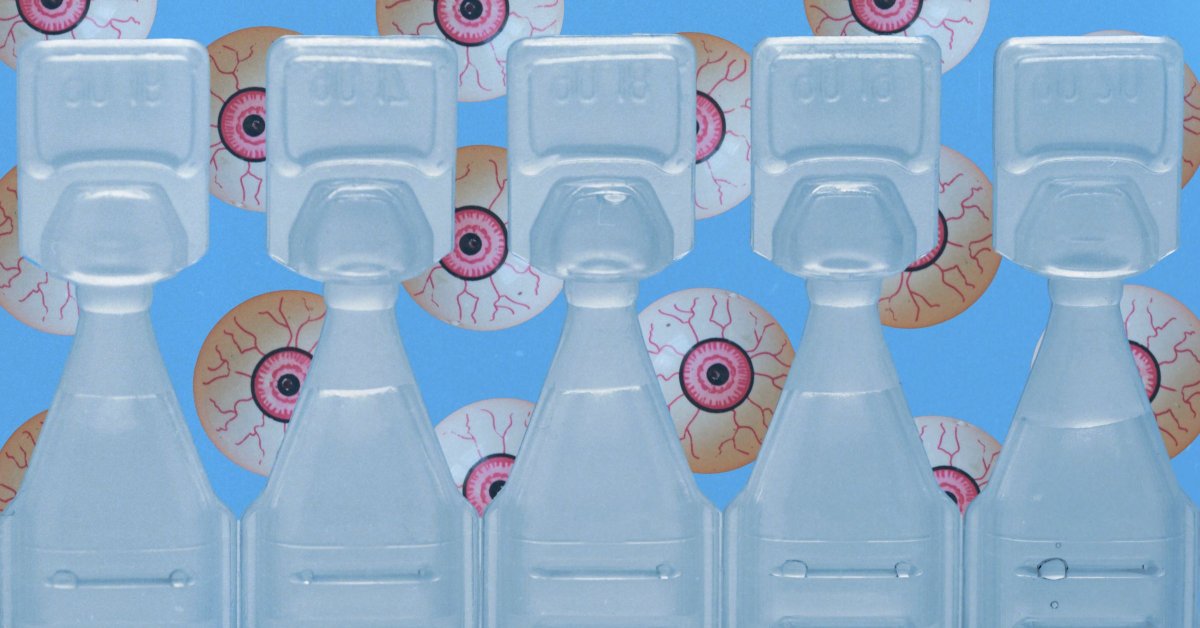Last October, when Talia Rotenberg was traveling to Europe, her eyes became bloodshot, watery, and painful—the same feeling she would expect if she had a torn contact lens in her eye. She was baffled, but assumed the unfamiliar environment might be triggering some sort of allergy. When she got back home to Los Angeles, however, the symptoms persisted.
Rotenberg, who’s 31, was surprised when her eye doctor told her what was going on: She had dry eye disease. “I’d never really heard of dry eyes,” she says. Flash forward a year, and her days are consumed with managing her condition; she’s traded her contacts for glasses, and even the slightest AC breeze bothers her eyes. She recently started new prescription eye drops, and hopes to see improvement within a few months.
Dry eyes affect millions of people each year, and research suggests the condition is on the rise. Yet, like Rotenberg, many people are surprised by their diagnosis—dry eyes aren’t on their radar. “People know their eyes are being bothered, but they don’t know why,” says Dr. Penny Aswell, a clinical professor of ophthalmology at the University of Tennessee Health Sciences Center who has researched dry eyes. Many people put off seeing an eye doctor. “A lot of them are out there walking around with dry eyes, and they’re not being taken care of.”
We asked experts exactly what it means to have dry eyes, why it happens, and how to find relief.
What is dry eye disease?
Our eyes need to be well-lubricated all day in order for us to be comfortable and see clearly. For that to happen, there needs to be adequate tear film (a layer of fluid) on the surface of the eye, says Dr. Daniel Brocks, a corneal specialist and chief medical officer of BostonSight, a nonprofit that treats people with severe dry eye disease. When there’s not enough tear film—either because your eyes don’t make enough tears, or because the tears don’t work correctly—you end up with dry eyes.
People with dry eyes commonly experience “irritation, or a sensation like grittiness or sand in the eye—we call it foreign body sensation, like there’s constantly a lash in the eye,” Brocks says. “You might also have red and inflamed eyes and sensitivity to light, all the way up to severe pain and inability to open the eyes.” Many people describe stinging or burning in their eyes and blurry vision; over time, infections and ulcers can develop.
Read More: Should You Shower in the Morning or at Night?
Research suggests that dry eye disease makes people less productive at work; the worse the dryness, the lower the person’s productivity. That extends beyond the workplace, too. “We get patients coming in who say, ‘I can’t read as much as I want to. It’s interfering with my driving,’” Aswell says.
Dry eye disease can be debilitating, Brocks stresses. “People truly suffer and can’t go outside or partake in their daily activities,” he says. “It really runs their lives.”
What causes dry eyes?
Dry eyes are most common among people ages 50 and over—though even kids can be affected—and women are at greater risk than men, Aswell says. Wearing contacts also plays a role: The thin lenses can reduce the amount of oxygen that reaches the cornea, interfere with the production of tears, and generally irritate and dry out the eyes.
Plus, dry eye disease is often linked to autoimmune conditions like lupus and Sjögren’s syndrome. One survey suggests that 95% of people with Sjögren’s, for example, suffer from dry eyes.
Environmental factors can contribute, too. Living in a dry area is much more difficult than living somewhere that’s humid year-round. “A humid environment is much more gentle on your eyes—there’s more moisture in the air,” Brocks says. “We’ll even have patients who literally move from [the North] down to Florida or whatever more humid location to have a better life.”
Read More: The Best Science-Backed Way to Stop Chafing
When patients come in complaining about dry eyes, Brocks usually asks how many glasses of water they drink each day, as well as how much coffee. “Caffeine is a diuretic—it gets rid of moisture—so some people just have the wrong balance of providing their body with proper moisture,” he says. He tells them to drink more water and cut back on caffeine, and when they come back for a follow-up, their eyes are dramatically less dry.
Certain medications, like those taken to lower blood pressure, can also exacerbate dry eyes. Allergy medications, including oral antihistamines, can cause or worsen the situation, too. “I always recommend anyone who has dry eyes have their doctors take a look at those medications, and sometimes there can be adjustments,” Brocks says.
Lifestyle and environmental modifications
One of the biggest reasons why dry eye disease is on the rise has to do with increased screen time. Blinking plays an essential role in tear production, and while our normal blink rate is about 15 to 20 blinks per minute, that plummets to 4 to 6 blinks per minute when we’re looking at a screen. “That can absolutely factor into dryness,” says Dr. Ami Vadada, a spokesperson for the American Academy of Ophthalmology and ophthalmologist at AdvantageCare Physicians in New York. To counteract the problem, she suggests following the 20-20-20 rule: Every 20 minutes, look 20 feet away from your screen for 20 seconds, which gives your eyes a much-needed break.
There are other things you can do at home. Artificial tears and lubricants, which are sold over the counter in a variety of brands, mimic your own tears and help rewet the eyes. “They can be used as often as you need,” Vadada says. “You can’t overdose on them.” She encourages patients to use gel drops at bedtime—they can cause blurred vision, which is why nighttime use is best, but they’re thicker than liquid drops and stay in the eye for longer. Many people also find it soothing to run a towel under warm water and gently massage their eyes, Vadada says.
Certain environmental modifications can help, too. Vadada suggests using a humidifier at home to keep your surroundings moist, and avoiding direct winds, like those blasting out of the AC in your car. “You don’t want to put the air conditioning directly into your face, which can dry out the eyes,” she says.
More aggressive treatment options
In particularly severe cases—especially when someone has an underlying autoimmune disease—OTC eye drops and lifestyle modifications will likely fall short. Some patients benefit from punctal plugs, which are tiny devices inserted into the tear ducts that help block the drainage of tears, helping the eyes retain more moisture. The procedure is quick and happens in the eye doctor’s office; typically, a patient’s eyes are numbed before the plug is inserted. “When the person makes tears, those tears will still go down the drain, but much more slowly,” Brocks says. “It’s like putting a plug in a sink.”
A variety of prescription eye drops also exist, and more are in the pipeline—Brocks describes it as “an area of huge growth.” One of the most effective options is cyclosporine, which reduces inflammation in the eyes and increases tear production. There’s even a nasal spray called Tyrvaya designed to activate the nerves in the nose, which in turn stimulates tear production in the eyes.
Brocks’ patients with severe dry eyes sometimes benefit from autologous serum eye drops, which are made from a patient’s own blood. “It’s been known for a while that there are a lot of healing properties in our blood, so we’ll send some patients to a lab to have them get a blood draw, and the lab will spin down their blood and take the clear liquid portion called the serum,” he says. “They’ll mix that with an artificial tear and create serum tears, which are drops given to you to use anywhere from four to 10 times a day.” They help heal the surface of the eye, in the process alleviating bothersome symptoms, and are “quite effective” for some people, he says. According to one randomized study, patients who used serum eye drops experienced significant improvement after two weeks of treatment.
Read More: What to Do About Your Red, Itchy Eyes
Another technique, called amniotic membrane graft, involves placing thin layers of tissue from a donated placenta onto the surface of the eye to promote healing. Amniotic membranes have anti-inflammatory properties, which can benefit the surface of the eye. “It’s sterilized and put into a contact lens,” Brocks says. “That’s placed on the eye for a short period, usually five to seven days, and then it dissolves. It has a lot of healing properties that can’t be found anywhere else.” In one study, the treatment improved symptoms for about 88% of participants who had been experiencing dry eyes; the researchers also noted that no adverse effects were reported.
Brocks focuses much of his attention these days on scleral lenses, which are large-diameter contact lenses that rest on the whites of the eyes, keeping the cornea hydrated and protecting it from irritation. “They’re customized to each person’s eye,” he says. “The lens is filled with saline every morning—it’s like a bowl, basically, and then that bowl is placed on the eye, and you’ve created this moisture chamber for the eye.”
Looking forward, Brocks is optimistic about how treatment options might improve for people with dry eye disease. “There’s a lot of new mechanisms being found, and there’s a lot of new medications in the pipeline that people are waiting for,” he says. “It’s one of these diseases that’s a little more complex than it sounds, and extremely common, especially as age increases. There’s such a variety of things that can cause it that we try to pinpoint,” and increasingly, an effective selection of current and emerging treatments.








